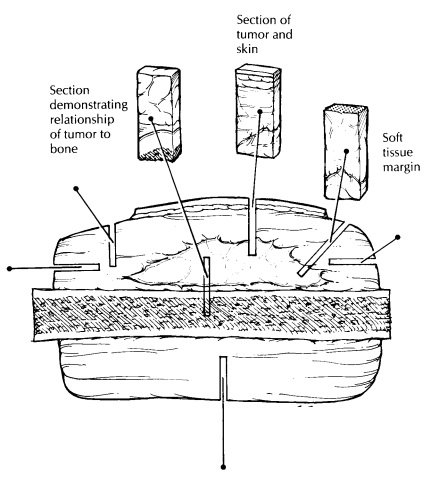Chapter: Surgical Pathology Dissection : Bone, Soft Tissue, and Skin
Nerve and Muscle Biopsies : Surgical Pathology Dissection

Nerve and Muscle Biopsies
Nerve
and muscle biopsies are subject to a variety of artifacts if they are not
properly handled. Furthermore, the interpretation of nerve and muscle pathology
frequently requires special studies, in-cluding electron microscopy and
histochemistry. For these reasons, nerve and muscle biopsies are best handled
directly by specialized laboratories. Each laboratory usually has its own
protocol for handling these biopsies. A detailed discussion of these specimens
is, therefore, beyond the scope of this book. However, you should be aware of a
few basics in processing these specimens, in case you do not have access to a
specialized neu-romuscular laboratory when the biopsy is done.
Muscle
biopsies are usually obtained as two strips of muscle approximately 3.0 × 0.5 cm, taken parallel to
the direction of the muscle fibers. A portion of tissue should be stretched to
its normal in situ length, pinned to
a card, and placed imme-diately (in the operating room) in 4% buffered
glutaraldehyde. Do not mince this
piece for elec-tron microscopy. The remainder of the biopsy should be
transported in saline-moistened gauze (do not soak) to the pathology
laboratory. A por-tion of the biopsy should then be immediately fresh-frozen
and the remainder fixed in formalin. To ensure that the fiber size in the
biopsy reflects the in situ diameter
and to reduce artifacts caused by the extreme contractility of the tissue, this
piece of muscle should also be stretched to its normal in situ length in the direction of the fibers. Thiscan be
accomplished with a special muscle clamp or simply by pinning the stretched
biopsy to a stiff index card. Be careful not to overstretch the tissue, as this
can cause artifacts as well. Muscle biopsies frozen in liquid nitrogen tend to
develop ice crystal artifacts, so it is best to freeze the tissue in
2-methyl-butane (isopentane) cooled to dry ice temperature or below. When
submitting muscle biopsies in formalin for histology, remember to submit both
longitudinal and cross sections.
Diagnostic
nerve biopsies to determine the cause of a neuropathy are usually obtained as
3-to 5-cm-long strips of the sural nerve. As was true for muscle biopsies,
these should be processed immediately by a specialized neuromuscular
lab-oratory. You should handle these biopsies only when they cannot be handled
by a specialized laboratory. Do not stretch these biopsies! In-stead, the
biopsy is usually cut into four pieces. One piece should be submitted in 4%
glutaralde-hyde for electron microscopy, one submitted in formalin for routine
microscopy, another fresh-frozen and stored at 2708C, and
the fourth saved fresh in saline-moistened gauze for the neuromuscular
laboratory. If you have to cut a nerve, be careful not to squash it while
cutting. Pressure on the nerve can induce the artifactual appearance of
demyelinization. As was true for muscle biopsies, the sections submitted for
histol-ogy should include both longitudinal and cross sections.
If a
nerve biopsy is performed simply to docu-ment the transection of a nerve, the
specimen should be entirely submitted in formalin for rou-tine paraffin
embedding and sectioning.
Related Topics